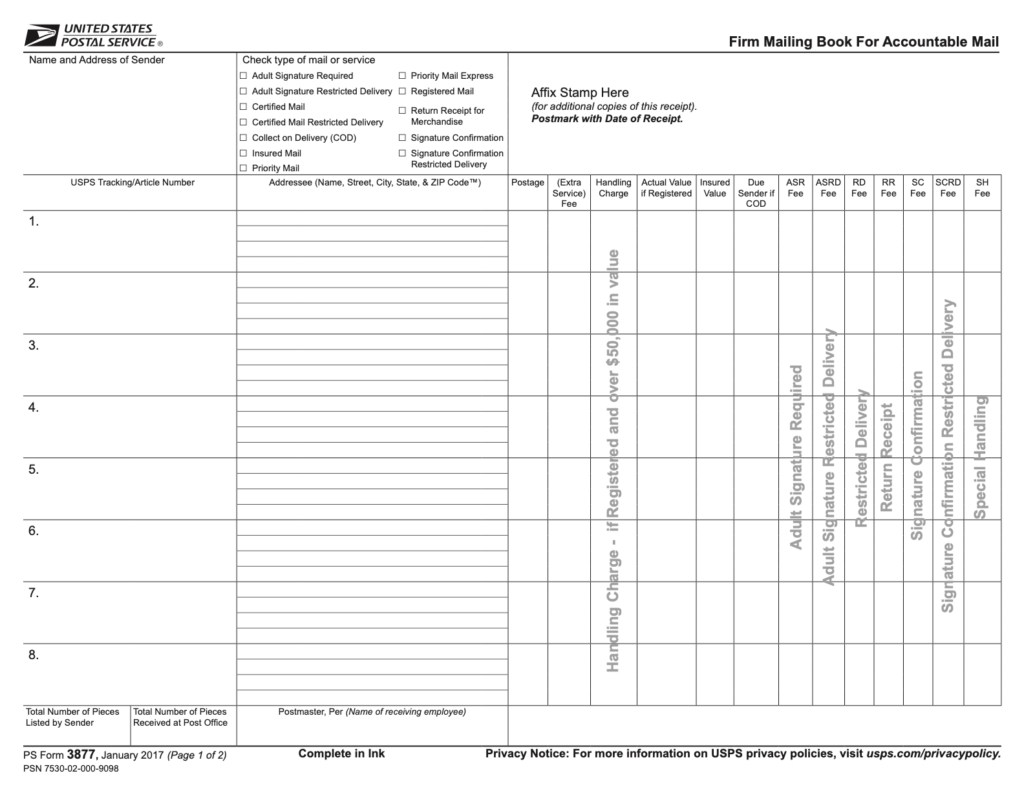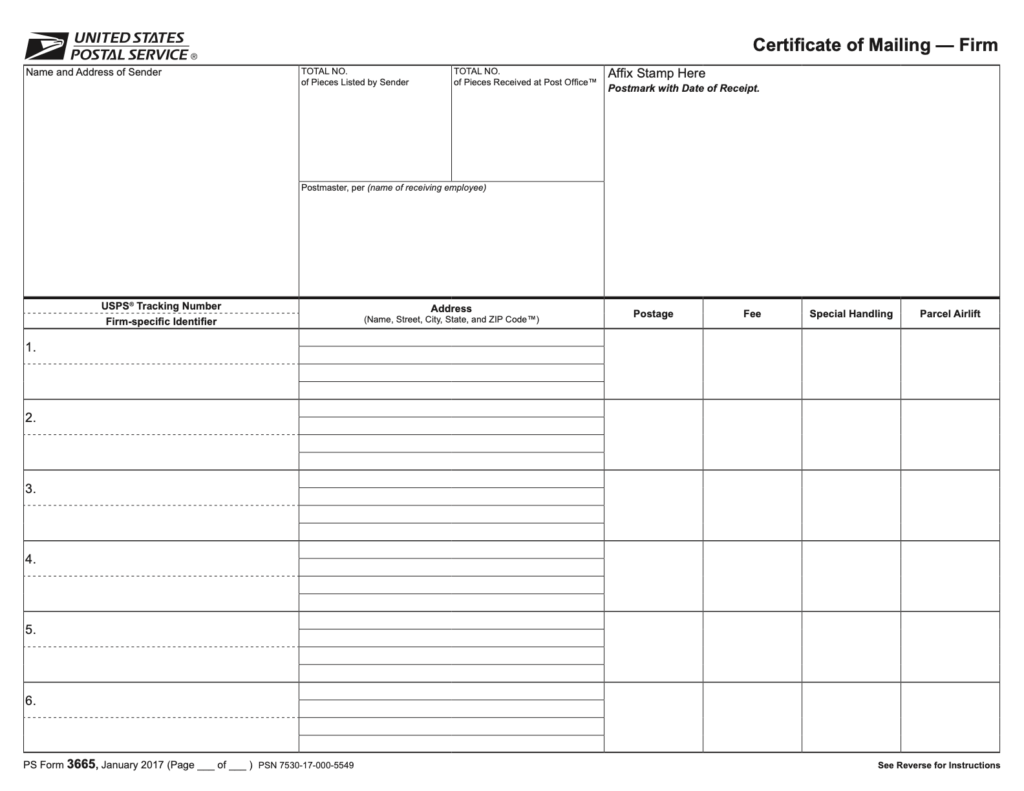While the names Certified Mail and Certificate of Mailing might sound similar, they are two very different extra services offered by the USPS that fulfill different mailing needs.
If you’ve confused the two before, don’t worry. Even the USPS has trouble keeping them straight sometimes. We occasionally hear from mailers that the window clerk at their post office is trying to charge them $0.58 for each piece of certified mail listed on their 3877. This is a misunderstanding on the part of the USPS employee, and the source of the confusion has to do with the difference between Certified Mail and Certificate of Mailing.
Before we address how to handle this situation with the USPS, it’s important to first understand the differences between these two extra services. So, here’s what you need to know:
Certified Mail vs Certificate of Mailing
Certified Mail is an extra service that provides the sender with a mailing receipt, tracking history, and, upon request, electronic verification that a mail piece was delivered or that a delivery attempt was made. The USPS maintains a record of delivery (which includes the recipient’s signature). If the mailer would like a copy of the recipient’s signature, Certified Mail can be paired with the Return Receipt extra service or Electronic Return Receipt extra service.
If you’re looking for a more thorough overview of Certified Mail, check out our article titled Certified Mail 101: Everything You Need to Know About Certified Mail.
Certificate of Mailing, on the other hand, is a far less comprehensive extra service. A Certificate of Mailing is a receipt that simply provides evidence that a mail piece has been presented to the USPS for mailing. It is an official record that shows the date your mail piece was accepted by the USPS. Unlike Certified Mail, a Certificate of Mailing does not include a record of delivery or tracking history, and a signature is not required upon delivery.
If you’re looking for a more thorough overview of Certificate of Mailing, check out our article titled What Is a Certificate of Mailing?
Which one should I use?
The extra service you select is completely dependent on your mailing needs.
Certified Mail is used when you need evidence of acceptance, delivery, and complete tracking history. In other words, when you need to have proof your mail piece was accepted by the USPS and delivered, or that a delivery attempt was made, Certified Mail is the way to go. Additionally, when paired with the Return Receipt or Electronic Return Receipt extra service, you’ll receive a copy of the recipient’s signature, meaning you’ll know exactly who received it.
Certified mail pieces also naturally receive more attention from recipients, as a signature is required and the green stripe on the top of the piece that reads “Certified Mail” conveys a higher degree of importance than an ordinary mail piece.
Comparatively, Certificate of Mailing is used when you simply need evidence that a mail piece was presented to the USPS for mailing on a certain day. If your mail piece is lost, damaged, or encounters some other problem in the mail stream, you can produce your receipt to prove your piece was in fact accepted by the USPS. However, you will not be able to prove that piece actually made it to its destination.
How much do they cost?
Since Certified Mail is a more comprehensive extra service, it costs more, at $4.40 per piece. The Certificate of Mailing extra service costs $2.00 for a single piece and just $0.58 per piece when sending three or more pieces with PS Form 3665.
All of the fees mentioned above are in addition to the cost of postage.
The USPS is charging me for each piece on my 3877. What can I do?
Now, back to our original question.
The confusion for some USPS employees usually has to do with the forms associated with these extra services. As you can see, PS Form 3877 (commonly used for proof of mailing for certified mail) looks very similar to PS Form 3665 (used for pieces sent with Certificate of Mailing).
However, upon closer inspection, you can see these two forms are actually very different. The easiest way to identify each form is to simply look at the heading in the upper right or the number in the bottom left.
When USPS employees see the 3877, they might mistake it for a 3665 and incorrectly assume you’re looking to send pieces with Certificate of Mailing. So, what do you tell the USPS employee who is insistent on charging you $0.58 per piece on your 3877?
The best solution here is to refer the USPS employee to the USPS Domestic Mail Manual (DMM). You can think of the DMM as the USPS Bible. It contains official prices and standards for all domestic mailing services. It’s a long document—1,323 pages to be exact—but it includes everything you’ll need to clear up the confusion surrounding this topic, and the USPS can’t refute it.
Specifically, you can refer the USPS employee to two sections in the DMM: 503.3.1 and 503.1.10.
Section 503.3.1 is on basic standards for Certified Mail services and specifies that a receipt is included with Certified Mail. It says…
“Certified Mail provides the sender with a mailing receipt and, upon request, electronic verification that an article was delivered or that a delivery attempt was made.”
Section 503.1.10 is on basic standards for receipts for all extra services (including Certified Mail) and specifies that the mailer can acquire his receipt with PS Form 3877. It says…
“Except for domestic certificates of mailing under 5.0, the mailer receives a USPS sales receipt and the postmarked (round-dated) extra service form for services purchased at retail channels. …For three or more pieces with extra or accountable services (includes international Certificate of Mailing) presented for mailing at one time, the mailer uses PS Form 3877 (firm sheet)…If the mailer wants the firm sheets receipted by USPS (postmarked), the mailer must present the firm sheets with the articles to be mailed at a Post Office. The postmarked firm sheets become the mailer’s receipts.”
We recommend printing these pages from the DMM and bringing them to the post office. While this might seem like a bit of trouble, the good news is this issue will likely only need to be resolved once at your particular post office. Given the importance of the pieces your sending with Certified Mail, you’ll be happy to have official proof of acceptance for them once the issue is resolved.


